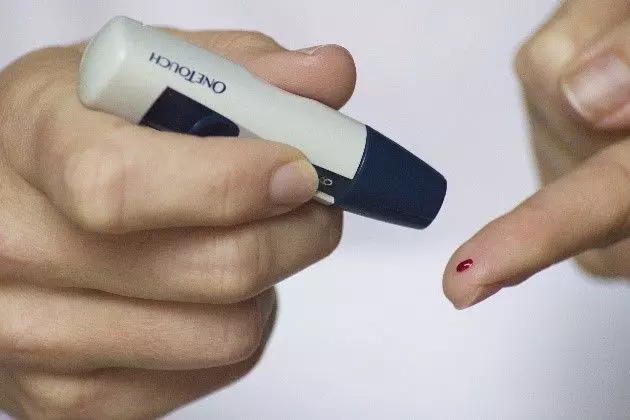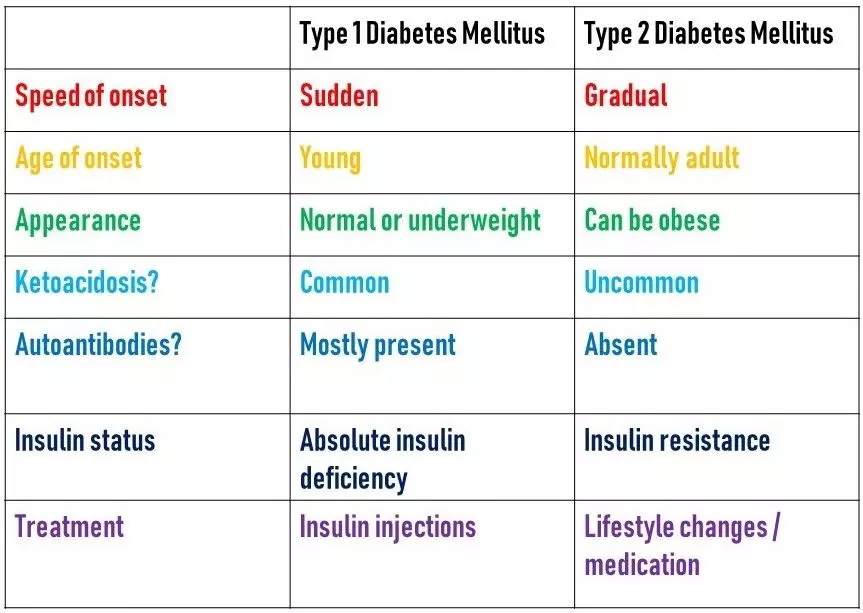Next Lesson - Calcium Metabolism
Abstract
- Diabetes mellitus is the term used for metabolic disorders characterised by chronic hyperglycaemia, which can be caused by insulin deficiency, insulin resistance, or both.
- Type 1 diabetes mellitus is most commonly diagnosed as a teenager, and is thought to be caused by a mixture of genetic and environmental factors.
- Type 2 diabetes mellitus is strongly associated with obesity, and is caused by insulin resistance.
- The triad of symptoms associated with diabetes mellitus are polyuria, excessive thirst, and weight loss. A person with type 2 diabetes may also have recurrent infections, lack of energy, and feet problems.
- Macrovascular problems associated with diabetes mellitus include increased risk of stroke, increased risk of myocardial infarction and poor circulation to the periphery.
- Microvascular complications include diabetic nephropathy, diabetic neuropathy, diabetic foot disease and diabetic eye disease.
- Metabolic syndrome is defined as a group of symptoms, including insulin resistance, dyslipidaemia, glucose intolerance, and hypertension, associated with central adiposity. It is most common in affluent areas prone to obesity.
Core
Diabetes Mellitus (DM) is the term used for metabolic disorders characterised by chronic hyperglycaemia (increased plasma glucose levels), which can be caused by insulin deficiency, insulin resistance or both. Diabetes mellitus is typically characterised as either Type 1 or Type 2, distinguished by their epidemiology and probable causation, but they cannot always be easily clinically distinguishable.
Type 1 Diabetes Mellitus (T1DM)
T1DM is most common in the young, and is usually diagnosed as a teenager. It is an autoimmune condition, which is thought to be caused by a genetic predisposition (although the inheritance pattern is currently unknown) mixed with an environmental trigger, producing an autoimmune reaction in which the production of lymphocytes, macrophages and auto-antibodies attack and progressively destroy pancreatic β-cells.
A typical patient would be a lean, young person, with a recent history of viral infection, who presents with a triad of symptoms: polyuria, thirst, and weight loss. This triad of symptoms is very characteristic of T1DM, and is explained below:
- Polyuria - the increased concentration of glucose in the interstitial fluid of the kidney decreases osmolality, causing excessive amounts of water to be drawn into the urine. There is also presence of glucose in the urine (glycosuria).
- Thirst - polyuria means the rest of the body isn’t retaining enough water.
- Weight Loss - the absence of insulin means glucose cannot be used as an energy source, so the body metabolises fat and protein instead.
T1DM is easily diagnosed by measuring the plasma glucose concentration. In diabetes the lack of insulin causes decreased uptake of glucose into adipose and skeletal muscle, and decreased glucose storage as glycogen in muscle and liver, meaning that plasma glucose levels become raised.
If T1DM is not treated early, patients can develop diabetic ketoacidosis. The high rate of β-oxidation of fats in the liver, coupled with low insulin/anti-insulin ratios, leads to the production of huge amounts of ketone bodies, such as acetoacetate, acetone, and β-hydroxybutyrate. Acetone is a volatile substance and is therefore breathed out and smelled on the patient’s breath. Symptoms of ketoacidosis include: prostration, hyperventilation, nausea, vomiting, dehydration and abdominal pain.
T1DM cannot be cured and must be managed for the rest of the patient’s life with insulin injections, which can vary in method of injection and half-life. The social and psychological implications of living with T1DM are vast, which can contribute to the degree of control of the condition achieved by the patient. Along with insulin, dietary management and regular exercise must be considered to better manage the condition.
The management of blood glucose requires frequent blood glucose measurement. A small amount of blood from a finger prick is sufficient to measure blood glucose using a BM stick and reader, however these devices are only accurate if used carefully. There is always a risk of a diabetic patient becoming hypoglycaemic, which must be treated with oral or IV glucose.

Diagram: An example of a BM stick used by patients with T1DM to measure their own blood glucose levels
Creative commons source by Reversing Your Diabetes Today [CC BY-SA 4.0 (https://creativecommons.org/licenses/by-sa/4.0)]
Type 2 Diabetes Mellitus (T2DM)
T2DM patients are typically older than those diagnosed with T1DM, and are usually overweight. It is generally caused by insulin resistance, which is compensated for by the pancreas increasing insulin production. However, over time pancreatic β-cell function decreases, and the patient suffers hyperglycaemia due to the inability of the pancreas to compensate for insulin resistance. At diagnosis the patient normally has around 50% of their β-cells functioning, but as this falls, disorders of insulin resistance and secretion worsen, increasing the patient's hyperglycaemia.
As with T1DM, patients will present with the classical triad of symptoms (polyuria, thirst, and weight loss), but will also present other symptoms such as lack of energy, persistent infections (particularly genital thrush or infections of the feet), slow healing minor skin damage and visual problems.
T2DM can sometimes be managed by diet and exercise alone, but if this is not the case then there are a vast number of drugs that can be used in T2DM management. These include metformin, which decreases insulin resistance, and sulfonylureas, which stimulate β-cells to release insulin.
Diabetes is diagnosed by the presence of symptoms, plus:
- A random venous plasma glucose concentration,
- OR a fasting plasma glucose concentration >7mmol/L,
- OR plasma glucose concentration >11.1mmol/L 2 hours after 75g anhydrous glucose in an oral glucose tolerance test.
With no symptoms, a diagnosis of diabetes mellitus shouldn’t be based on a single glucose determination alone. A diagnosis of diabetes has important legal and medical implications for the patient, meaning that a correct diagnosis is essential. A diagnosis should never be made on the basis of glycosuria or a stick-reading of a finger-prick blood glucose alone, although such tests may be useful for screening.
Complications of Diabetes Mellitus
Persistent hyperglycaemia is associated, in some tissues, with the abnormal metabolism of glucose into products that may be harmful to cells. This is because the uptake of glucose into the cells of some tissues, such as peripheral nerves, the eyes and the kidneys, does not require insulin, and is determined instead by extracellular glucose concentration. When a patient is experiencing hyperglycaemia, the intracellular concentration of glucose in these tissues increases, and glucose is metabolised in the following reaction, catalysed by aldose reductase:
Glucose + NADPH + H+ -> Sorbitol + NADP+
An increase in the above reaction depletes cellular NADPH, weakening the defence system of these cells and allowing disulphide bonds to form in cellular proteins, altering their structure and function. In addition, the increased accumulation of sorbitol causes osmotic damage to cells.
Persistent hyperglycaemia is also associated with the increased glycation of plasma proteins. The extent of glycation depends on the glucose concentration and the half-life of the protein. Glycation changes the net charge and 3D structure of the protein, therefore affecting the protein's function. Glucose can react with the terminal valine on haemoglobin to form glycated haemoglobin (HbA1c). The %glycated haemoglobin in the blood can be used as an indicator to detect how effective treatment has been.
Long-term diabetics suffer from a number of macrovascular and microvascular complications, made worse in individuals whose blood glucose is poorly controlled.
Macrovascular complications include increased risk of stroke, increased risk of myocardial infarction and poor circulation to the periphery (particularly to the feet).
There are a wide range of microvascular complications, which are explained below:
- Diabetic Eye Disease - this is usually caused by diabetic retinopathy, in which damage to blood vessels in the retina caused by hyperglycaemia can lead to blindness. The damaged blood vessels may leak and form protein exudate on the retina, or they can rupture and cause bleeding to the eye.
- Diabetic Kidney Disease (Diabetic Nephropathy) - hyperglycaemia causes damage to renal glomeruli (renal blood vessels) and can increase the number of urinary tract infections (glucose in the urine provides a substrate for bacteria), all of which damage the urinary tract. An early sign of diabetic kidney disease is proteinuria.
- Diabetic Neuropathy - hyperglycaemia damages peripheral nerves in a number of ways, which can cause a change in or complete loss of sensation.
- Diabetic Foot Disease - an accumulation of poor blood supply, damage to nerves, and increased risk of infection all mean that risk of damage to the feet is greatly increased in diabetics.

Diagram: Table outlining the main comparisons between type 1 and type 2 diabetes
SimpleMed original by Jenny Hubball
Metabolic syndrome is defined as a group of symptoms, including insulin resistance, dyslipidaemia, glucose intolerance and hypertension, associated with central adiposity. These symptoms may be related to insulin resistance, as they are commonly found in patients with T2DM. Metabolic syndrome is seen commonly in the obese, and is related to an increase in obesity-related morbidity. The major factors that predispose the population to metabolic syndrome are obesity and a sedentary lifestyle, with the insulin resistance that results being associated with the development of a dyslipidaemic profile (↑VLDL, ↓LDL, ↓HDL) that is highly atherogenic. It is also associated with an increased risk of hypertension. The WHO criteria for metabolic syndrome are the following symptoms:
- Central obesity, with a waist:hip ratio of >0.9 in men and >0.85 in women
- BMI >30kg/m2
- BP > 140/90mmHg
- Triglycerides >1.7mmol/L
- HDL cholesterol <0.9mmol/L in men, and <1mmol/L in women
- Glucose fasting or 2 hours after a glucose load >7.8mmol/L
Metabolic syndrome is increasingly prevalent in developed countries, and is present in 80% of people with type 2 diabetes.
It is important to note when diagnosing metabolic syndrome that BMI does not allow for large muscle bulk, and it is known that central fat around the abdomen, not just total body fat collection, is associated with insulin resistance, fatty liver and other symptoms in metabolic syndrome. This means that BMI is not an ideal measurement of central fat.
Edited by: Dr. Thomas Burnell
- 10711

